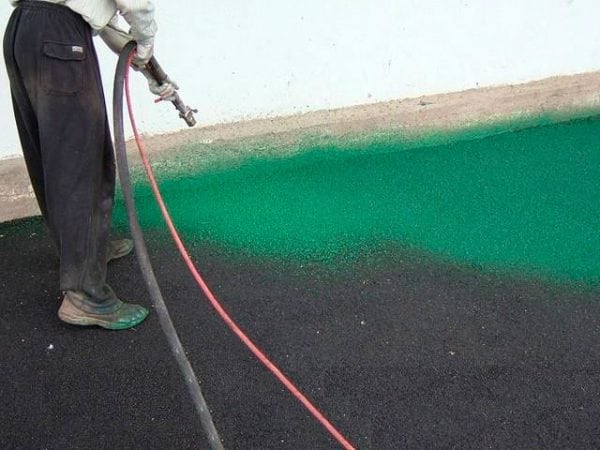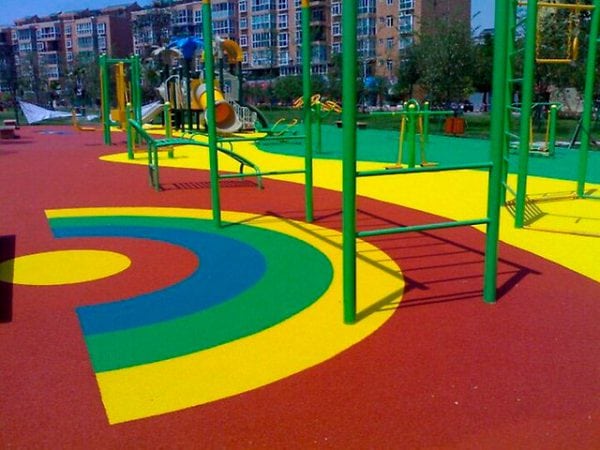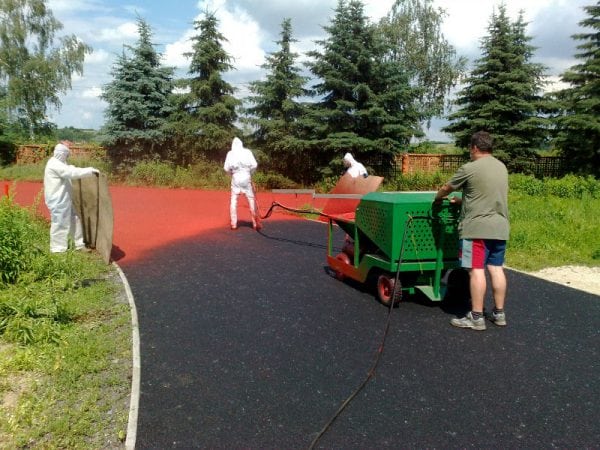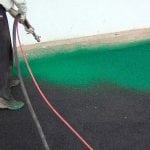Spraying with rubber materials ensures the filling of all joints, pores and microcracks and creates impermeability to water, steam and gas. Laying an integral seamless layer is considered an innovative achievement for creating a waterproofing and anti-corrosion coating on various surfaces.

Rubber spraying
Liquid rubber spraying is a technological process using special equipment that can solve even the most difficult tasks related to ensuring the protection of numerous objects in various spheres of human life (construction, mining, railway and automobile industry, public utilities, environmental protection, agriculture and marine etc.).
You can make a protective coating with the presented material by ordering a service from specialized organizations or by providing protection for your needs yourself. To give a more aesthetic appearance and additional protection, a decorative paint specially designed for this material can be applied to the resulting surface.
Advantages of using rubber material for surface protection:
- fast painting and perfect processing of the most difficult terrain, envelops all corners, ledges, envelops pipes, wires and drains;
- differs in a long term of use;
- It does not require frequent repairs, but if necessary, it is easily corrected, it does not require large expenses for updating, since only the area that has been broken is repaired;
- when laying smudges do not arise;
- the paint adheres firmly to any surfaces (concrete, metal, brick, wood);
- one hundred percent impermeability, since all cracks and pores in the covered base are filled;
- full protection against chemical and water corrosion, resistance to ultraviolet radiation;
- complete absence of seams, joints;
- does not emit toxic substances, completely safe paint;
- resistance to any punctures and cuts;
- equipment used for applying material, simple to operate.

How to do the work yourself
It was said above that it is possible to carry out such a process yourself, because small areas of surfaces do not require special skills, and it is not difficult to apply rubber material, the main thing is to be diligent and have the appropriate equipment. Consider this process on the example of the roof. In order to carry out the work correctly, first you need to correctly calculate everything, because for laying rubber paint it is necessary to take into account the load indicators that the roof can withstand, therefore, for this, such indicators are calculated:
- To paint one square meter with a thickness of 1 mm, approximately 1.5 liters of rubber compound must be used.
- To seal cracks, pores, seams and protect against corrosion of a metal roof, a layer of a composition of at least 1.5 mm must be applied.
- To isolate wood structures from water, it is optimal to lay a layer of material 1.5 mm thick.
- For membrane roofing, rubber material must be applied with a thickness of at least 2 mm, but it is best to lay it in 3 mm.
- To protect concrete or reinforced concrete surfaces from corrosion, lay a layer of the composition of at least 3 mm.
Now we are preparing special equipment for applying the rubber composition. To do this, use a specialized apparatus that works without air. It is considered universal and runs on gasoline fuel or electricity. The main condition is to thoroughly prepare the surface, clean it from dirt and debris. With the technology of applying paint, all defects, cracks and pores are filled with the applied material.
So, we begin to spray the composition using the prepared equipment. This painting refers to the mechanical method and is applied to a clean surface using equipment connected to a vessel containing a polymer-bitumen emulsion and to the tank, where the hardener with calcium chloride is located. These two components, mixing in the nozzle, are applied to the surface, resulting in a bitumen-polymer layer of the required thickness. (2-4 mm). As you can see, to carry out such a process is not at all difficult, the main thing is to have the necessary equipment and desire.

Application of rubber crumb
Above we talked about the characteristics and use, about spraying rubber in liquid form, and now let's talk a little about spraying rubber crumb. This type of coating appeared relatively recently, about 10 years ago, and if properly laid, it can last for a long time.
When using such a material, an airtight surface is created, uniformly distributed over the entire solid base.
This application has many advantages:
- The surface is absolutely non-slip, a perfect bond is formed with the soles of shoes and car tires, because a grainy texture is created.
- Long service life.
- Low consumption of the composition, when creating a rubber layer, a thickness of 3-30 millimeters is formed.
- The layer is continuous and without seams.
The only drawback is that for a large area you need to use specialized compressor equipment that runs on software, and it is only in organizations that provide these services.
Laying the composition with rubber crumb is possible on a wooden, concrete, asphalt, ruberoid and slate surface. Such material is usually applied in 2 layers: the first is created manually (10-12 mm), the composition is crumb, polyurethane adhesive and pigment paint; the second layer (3 mm) is automated.
to contents ↑DIY spraying
Such a process can be carried out independently if you need to cover small areas. For this you need - rubber crumb, polyurethane adhesive for a bunch, solvent, paint, if you want to make a colored surface, two buckets, a hand blender, a bucket with a measuring scale, a spatula, a leveling roller. Work in warm weather (+10 and above).
So, we begin the laying process:
- We clean the surface of all contaminants and putty all the slightest defects.
- Remove dust and degrease with a solvent.
- Ground the base with a thin layer of glue with polyurethane.
- We make a breakdown of the area, arrange the beacons.
- We prepare the composition - seven liters of rubber crumb, one liter of polyurethane adhesive, thoroughly mix.
- We apply the composition with a thickness of more than ten millimeters, align with a spatula;
- We roll the layer with a roller.
- Hardening occurs within 12 hours.
Today, the Russian market is saturated with a large assortment of these materials, which are divided into two groups (universal, specialized), therefore, before purchasing rubber materials, carefully study the information about them and the manufacturers, because the durability of your surfaces will depend on the quality of the selected products .




